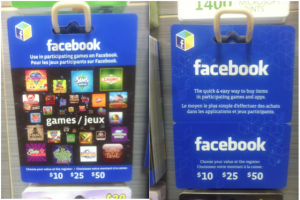I was just recently away on a road trip with my soccer team to Regina and Saskatoon. While on these road trips, we aren’t really able to do too much other than rest in our rooms, do our school work, and play the games we came to play. However, on the first night there a teammate and I got bored and decided to walk to a gas station to get some snacks and water. I was pretty efficient and got what I wanted quickly, but my friend took awhile to make her decisions so I wandered the store just browsing while I waited for her to make her selections. Who knew boredom would turn up something interesting…
I was looking at all the gift cards you can buy for various companies through 7Eleven and I came across a gift card for Facebook apps! I had no idea this existed. These gift cards looked similar to the ones iTunes sells except these were to purchase apps within Facebook. What first got me was that I thought everything on Facebook was free, but seeing these cards told me differently.
I find this super interesting following Facebook’s performance in the Nasdaq since it’s IPO last year. When it opened at 38$ back in May, Facebook thought it was at a good competitive price, but investors quickly realized that it’s revenue stream wasn’t strong enough to support it and the stock quickly dropped more than 50% in the first 3 months. Since its IPO disaster, Facebook’s stock climbed up to an all time high of 40$ in August and is currently at $49.46. This massive recovery is due to Facebook finding alternate sources of revenue to support the company and I am now wondering if this is one of those revenue strategies. Its seems very out of Facebook’s character and I wonder how people are reacting to it, or even if Facebook is selling any of these gift cards. The money on these gift cards doesn’t go towards buying an app, but it gives you money to use inside of an app (if that makes any sense). It’s kind of like if you were playing SIMS and spent money, but it isn’t fake money, it’s your real money. This seems weird, and the option to buy these cards are only in certain regions, but I don’t think I as a consumer would ever have the desire to purchase one of these. I’d be interested to hear from someone who has bought one and how they used it.
All in all, this post is just voicing my curiosity surrounding Facebook’s big turnaround, and I wonder how much this alternative type of revenue strategy is actually helping them. Many digital start-ups, and social media platforms have struggled with finding sustainable revenue streams, could this be one of them? And are consumers going to buy in?

